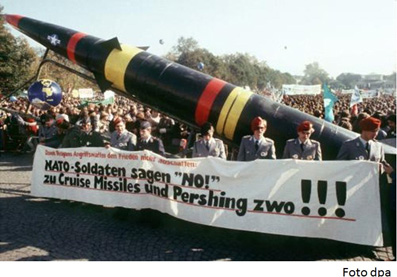 |
Peoples' movements and protests |
 |
|
MobilizationsThe peace of God and the communeThe war resistance around 1900The Algeria movement in France50-60s nuclear resistanceVietnam War Resistance in the United States80s nuclear resistanceMobilizations against African civil wars
Back to Peace movementsBack to main page |
80s nuclear resistance
The long recession after 1973 reduced the scope for various government and capital groups and increased competition. One result of this was that the so-called policy of detente failed in the late seventies and both the United States and the Soviet Union began to invest in new weapons systems, and even consider the possibility of annihilating their counterpart in one go. A consequence of this was a mobilization of peace movements, mainly in Europe, of a size which the world has not seen before. The initiative came in 1978 from the Dutch churches, which had discussed the issue of peace together since the sixties. They received quick support from Norwegian churches and youth organizations. But it was in West Germany that the popular movement mobilization was greatest. In a short time, local groups in each city were mobilized, coordinated in five different networks with different ideological profiles, which in turn were coordinated by congresses and a national action committee. The goal was that no new robots would be placed on West German soil. For this purpose, millions demonstrated while more militant groups carried out blockades and occupations, this time without causing any resentment within the movement. In other countries, such as the United Kingdom, France, Italy, the Nordic countries and the United States, mobilization was not quite as strong. But it was strong enough to be the largest mass mobilization in twenty years. Despite this, the movement failed to achieve its original goals. The new weapon systems were deployed, after which the movement slowly faded away. There are several explanations for why this happened. Some believe that the focus on a single decision left the movement, at least in West Germany, completely confused after the decision was made. Others have pointed out how even before the decision, the debate had become so fixated on weapons technology that it was conducted by defense experts far above the people’s heads and blocked all discussions of political priorities. Still others point out that the leadership of the movement had entered into such firm alliances with various political opposition parties that they were completely helpless when these parties eventually decided to ignore the issue. The
movement, on the other hand, became more important in other areas. And by mobilizing against a US-Soviet-led rearmament by referring to a European identity, the movement helped create a popular legitimacy for the European bourgeoisie’s imperial dream of the EU, which gained new strength shortly thereafter. Unlike in the nuclear resistance of the 50s and 60s, the North-South divide completely disappeared from focus.
Reading
|

